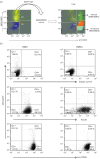Marek's disease virus infection of phagocytes: a de novo in vitro infection model
- PMID: 28548038
- PMCID: PMC5656796
- DOI: 10.1099/jgv.0.000763
Marek's disease virus infection of phagocytes: a de novo in vitro infection model
Abstract
Marek's disease virus (MDV) is an alphaherpesvirus that induces T-cell lymphomas in chickens. Natural infections in vivo are caused by the inhalation of infected poultry house dust and it is presumed that MDV infection is initiated in the macrophages from where the infection is passed to B cells and activated T cells. Virus can be detected in B and T cells and macrophages in vivo, and both B and T cells can be infected in vitro. However, attempts to infect macrophages in vitro have not been successful. The aim of this study was to develop a model for infecting phagocytes [macrophages and dendritic cells (DCs)] with MDV in vitro and to characterize the infected cells. Chicken bone marrow cells were cultured with chicken CSF-1 or chicken IL-4 and chicken CSF-2 for 4 days to produce macrophages and DCs, respectively, and then co-cultured with FACS-sorted chicken embryo fibroblasts (CEFs) infected with recombinant MDV expressing EGFP. Infected phagocytes were identified and sorted by FACS using EGFP expression and phagocyte-specific mAbs. Detection of MDV-specific transcripts of ICP4 (immediate early), pp38 (early), gB (late) and Meq by RT-PCR provided evidence for MDV replication in the infected phagocytes. Time-lapse confocal microscopy was also used to demonstrate MDV spread in these cells. Subsequent co-culture of infected macrophages with CEFs suggests that productive virus infection may occur in these cell types. This is the first report of in vitro infection of phagocytic cells by MDV.
Figures





References
-
- Calnek BW. Pathogenesis of Marek's disease virus infection. Curr Top Microbiol Immunol. 2001;255:25–55. - PubMed
MeSH terms
Grants and funding
LinkOut - more resources
Full Text Sources
Other Literature Sources
Research Materials
Miscellaneous

